HubSpot is a world on its own and has a variety of capabilities that you probably don’t know about - yet. This article takes you through HubSpot Dashboards and all the cool features it has to offer.
HubSpot offers exceptional reporting functionality for everyone from sales to service teams. One of the greatest features may be one of the most underrated: Dashboards. This article will dive into our favourite tips, tricks, and features with you.
Dashboards are an essential tool for organising your reports which will allow you to have one place to view your key metrics.
Here are the key things you can do with dashboards that you might not know about:
1. Filtering Dashboards
HubSpot dashboards all allow filtering by the same field. So, as opposed to changing each individual report, or creating an entirely new report for every date range, you can just filter the whole dashboard.
This feature is also user-specific. So for example, if the sales reps want to view data from this month and the sales manager wants to view data from 2021 as a whole, everyone can use the same dashboard and just filter by the date they want to see.
To filter your dashboards, in HubSpot:
- Navigate to your Dashboard.
- Once you’re on your dashboard, select ‘Filter Dashboard’ on the top left.
- Then select the filter you’re looking for.
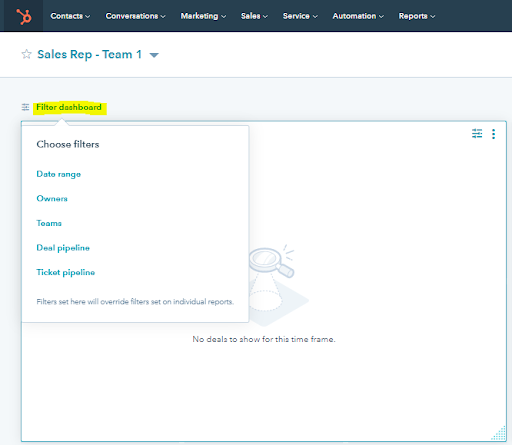
2. Adjusting Permissions on Dashboards
Some of the dashboards that you create might contain some sensitive information, which you don’t want everyone in the business to see, and this is where HubSpot’s Dashboards permissions come in.
This feature allows you to choose who can view and edit your dashboards. On a pro package, you can set dashboard permissions to:
- Private to owner
- Anyone can view
- Anyone can view or edit
If you're on the Enterprise package, you can set permissions to specific users and teams.
The option to control your dashboard visibility will pop up when you're creating a new dashboard. The default is that everyone can view and edit, but you can change this according to your preferences.
 If you’re creating a dashboard for someone else and they want it to be private, create the dashboard, get approval and then change the owner and set permissions to “private to owner”.
If you’re creating a dashboard for someone else and they want it to be private, create the dashboard, get approval and then change the owner and set permissions to “private to owner”.
To edit permissions on your existing dashboards in HubSpot:
- Click the button on the top-right that has ‘Assigned: in front’
- Then choose the access required.
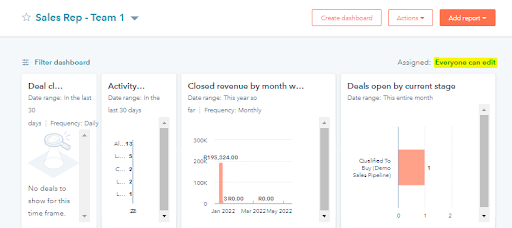
3. Dashboard Descriptions
Another feature we love about dashboards is the ‘description’ option. You can now add descriptions to your dashboards which will help give context to a dashboard - particularly useful in onboarding new team members.
For instance, if you’re using a dashboard to structure your monthly meetings, your description can include the meeting agenda. Here’s an example:
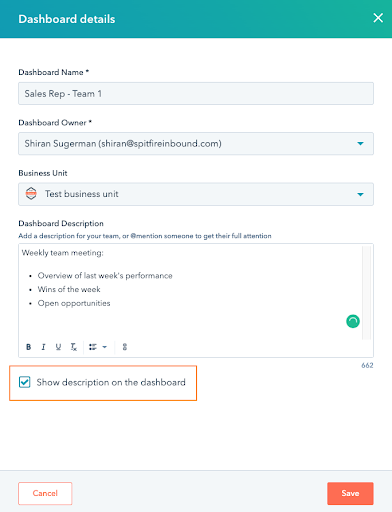
When using descriptions, remember to select the “show description on the dashboard” option so that this appears on your dashboard all the time.
4. Inserting images, text or video
HubSpot likes to make your life easy so they have introduced a feature where you can add images, text or videos to your dashboards. You may wonder when this would be relevant. Well, for the most part, you might not use this particular feature but HubSpot does have some limits (you get 25 dashboards on pro and 50 on enterprise) and if your team is quite large you might need to get creative with your dashboard designs.
An example of where we use the text feature is either for clients who want to make the dashboards branded (with logos and other elements) or to split out sections of the dashboard. Here’s an example:

Here’s how you can add text, images or videos to your dashboard:
- Make sure that you’re in your dashboard
- Navigate to Actions > Insert Images, text, or video
- A text panel will appear and you can now add your description
Here are some recommendations for adding these elements:
- Videos: Add video content that provides context to a project that the dashboard is tracking. For instance, a dashboard centred around web analytics can include a video describing and explaining the different metrics in web analytics.
- Images: When creating dashboards for your clients, try adding their logo to it. You can also add a header image tailored to the specific brand or project.
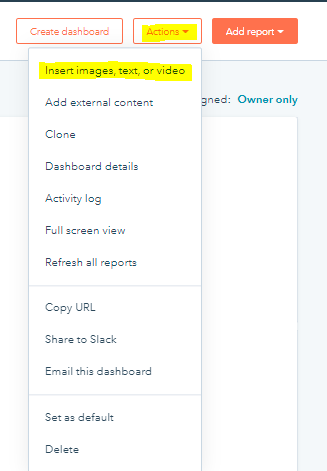
Just remember that new reports or images automatically get added to the end of a dashboard, you can simply drag them to where you want them further up on the dashboard.
5. Embedding External Content
HubSpot's content embedding feature is simply brilliant! You can now choose to add a piece of external content anywhere on your dashboard. You can add third-party reports, a spreadsheet, a presentation, and more.
Why would you want to do this? Again, to make your life easier. If for example, you report from both Google Analytics and HubSpot, adding your Google Analytics report to your dashboard means you don’t have to toggle between tools. You can also add working documents through Google sheets or slides which can be edited on the dashboard!
Take note though, embedded content retains the restrictions of the third-party app so if a user has permission to view the dashboard but not the Google sheet, they will not be able to view the Google Sheet doc. Also, if you get an error when trying to embed from your third-party app, it’s likely a permission restriction on the third-party app’s side.
There are two ways to embed content into a dashboard:
- Navigate to ‘Actions’ on your dashboard
- Select ‘Add external content’
- Choose the content type
- Add the relevant info
Spitfire tip: for Google Analyics choose the ‘Other content’ option and add the link to the Analytics report.
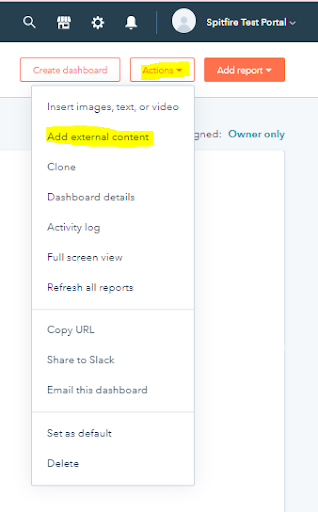
-Jun-22-2022-09-49-17-13-AM.png?width=504&name=unnamed%20(1)-Jun-22-2022-09-49-17-13-AM.png)
6. Emailing dashboards
Chances are you have to report to a board of directors or Exco team who most likely won’t be logging into HubSpot. With the ‘email this dashboard’ feature you can set up your dashboard to be sent one time or recurring via email to key stakeholders. This is particularly useful if you do weekly or monthly check-ins or convene Exco meetings.
To use this feature:
- Navigate to ‘Actions’ on your dashboard
- Select ‘Email this Dashboard’.
-Jun-22-2022-09-50-55-08-AM.png?width=310&name=unnamed%20(2)-Jun-22-2022-09-50-55-08-AM.png)
You can then schedule it according to your preferences:
-4.png?width=380&name=unnamed%20(3)-4.png)
This feature allows you to send the dashboard reports to the person with the dashboard default filters or you can choose a specific filter for this send. For example, if your dashboard has the standard date range of This Month you are able to set the filter to this week if you are using the same metircs for a weekly report.
Keep in mind that in order to use this feature the person has to be a user on HubSpot. They don’t ever have to log in to the system but the report send access requires them to be a user.
Spitfire tip: always choose an attachment when sending dashboards or reports (yes, you can do all this with an individual report tool). This will make it easy for the recipient to download the report and will ensure it’s viable if they use Outlook and images are blocked.
Our clients love dashboards because it gives them a one-stop-shop to viewing their key metrics. Remember, it’s important to keep in mind the reason behind why you need the dashboard. Don’t simply build a dashboard for the sake of it, create your dashboard to help your team grow.
P.S. if you’re looking for some insights into how to report in HubSpot, take a look at our reporting series: Show your value as a sales department with these key HubSpot reports, 11 HubSpot charts to show your value as a marketing department and Reporting requirements of your CRM to grow your business in 2021.
If you’ve got any questions, or need more guidance on HubSpot dashboards and reports, be sure to get in touch with one of our experts and we’ll gladly assist.
